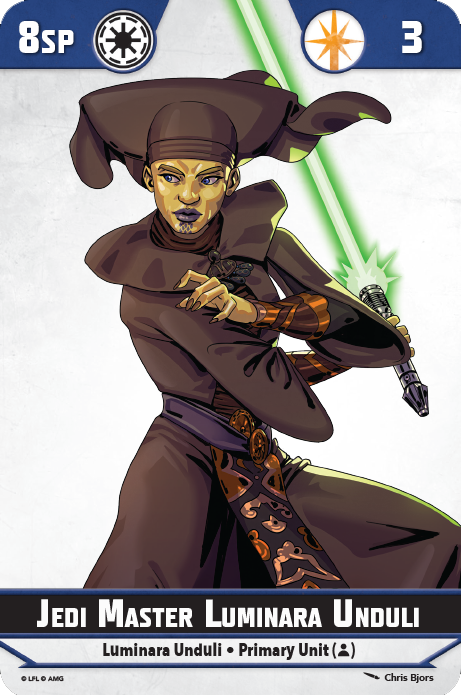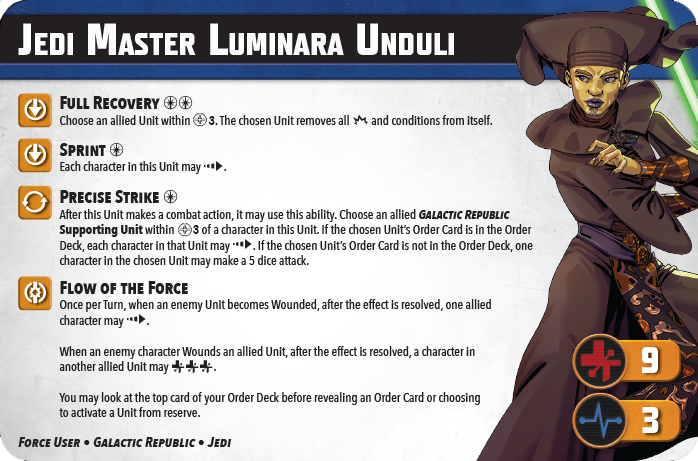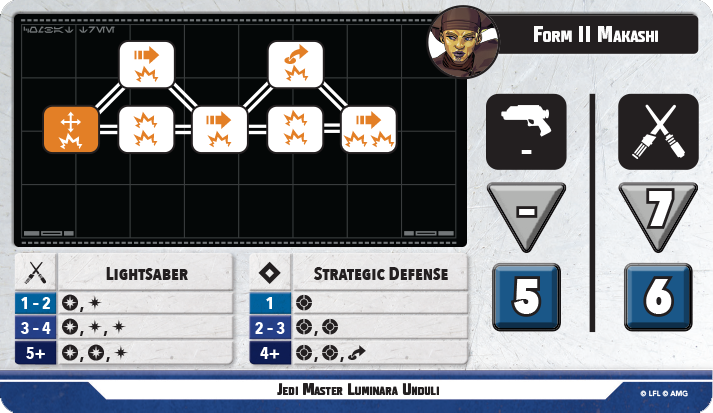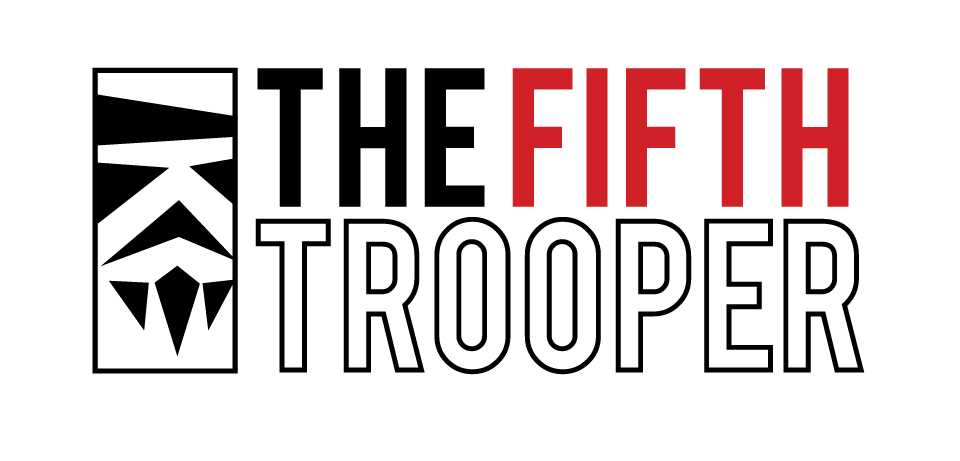Updated January 2024
Luminara is one of the more contentious units in Shatterpoint thus far. She received some very high and very low rankings in our 2023 community tier list project. I personally fall into the “Luminara is awesome” category, so hopefully this guide can explain why.
Jedi Master Luminara Unduli is available in the Plans and Preparation squad box.
Main Card
Nothing too special here, 8SP and 3 force are pretty standard. I like the pose, though!

Abilities

Luminara is on the low end of primaries with 9 stamina and 3 health, but as we’ll see later she has one of the best defensive stances in the game. As such, she can be quite tanky when not exposed.
Full Recovery initially looks very spicy, but in practice I’ve found it quite situational. One-shots are common in this game, and you can’t heal damage off a wounded unit (you can take conditions off, but I wouldn’t with this). The two force base cost is quite steep on a three force primary. Over the course of, say, a three round gameday, I would use it maybe once in those three games. I can’t say I’ve ever reserved Luminara so that I could pull out Full Recovery at just the right time, but if you draw Luminara at just the right time then healing a critical unit on death’s door feels great.
When looking at Jedi with Force Jump or Force Speed, there are pros and cons to each. Luminara’s Sprint is, unfortunately, the cons of both. You use the short tool and can move vertically without an ingress point. Combine this ability with only having a melee weapon and Luminara can sometimes struggle to get an attack off on her first activation without a little extra boost. Once embedded though her mobility isn’t really an issue.
Precise Strike is one of the most “meh” abilities out there right now for me. Range 3 is not an especially large bubble, and the effect you get depends on where the unit’s order card is in the deck. These two effects together make it rare that you’ll actually get the effect you need. On top of that, the one force base cost means I want it to be the difference in claiming an objective or not. Once in a while Precise Strike can be useful, but I usually run Luminara without any clone supports and I don’t miss the ability.
So if her first three abilities are only OK, why is Luminara so good? Her best part by far is her identity, which gives three banger abilities in one, and they’ll always be free! Conveniently, I think the order their listed in on her card is also how I would rank them in terms of importance.
- Out of activation movement is huge in the objective game, and Luminara can give any friendly unit (regardless of tags) a dash when an enemy is wounded. It only happens once per turn, but that’s enough. This ability doesn’t even have to be paired with a super damage-heavy list in my opinion. Even low to mid damage lists are getting four-ish wounds in a three struggle game. If a dash wins you an extra objective in just two of those instances then that’s a game-changer. Luminara pairs well with primaries who are strong, but lack the ability to move friendly units, such as Obi-Wan, Maul, or Vader. I talk a lot about swing, and giving every activation in the game +1 swing potential is massive.
- Heals are great! The heals from Luminara’s identity are most effective when your opponent is splitting fire. While they may prefer to focus one unit down, the reality is that isn’t always an option. For example, round one of Sabotage Showdown usually sees the fight happening in two far-away spots on the board. One turn they may attack a unit on one side, the next they may draw a unit on the other side. Sometimes players leave multiple units almost wounded at the end of one struggle so they can farm easy momentum in the next struggle. With Luminara that’s much harder because as soon as one unit is wounded, the other can get three heals. Finally, a rules reminder. The friendly unit that gets wounded can’t perform the heals, but that doesn’t mean they can’t get healed by a friend. Let’s say an opposing Obi-Wan attacks and wounds your commandos, applying three conditions. A nearby character can be nominated for Luminara’s identity ability and use those three heals to heal the conditions off of the commandos, provided they are in range 2.
- The order of the order deck is currently the only secret information in Shatterpoint, and it’s secret to both players. At least until Luminara shows up. Getting extra intel helps you be more effective, especially in the later struggles when the priority objective is moving around. The ability is only useful when you have a card already in reserve, otherwise you’re just peeking at the card you’re about to draw. However, when you have a card in reserve is when you really want to know what’s coming next, because if it’s a bad draw you’ can’t just reserve that new card.
Form II Makashi

When Luminara is attacking this is usually the stance I want her in. As such, she always starts the game in this stance so she can attack then flip to her other side at the end of her activation. As I mentioned earlier, her mobility beyond the first activation is rarely a concern, and we see now that’s because she gets a reposition to start her tree. After that she can double shove an enemy if she wishes. Early shoves are always great, and getting to reposition first means she can line up just the right angle for those shoves to be most effective. With seven attack dice and two results on one expertise this is an extremely solid attack profile.
Defensively this stance is fine. Not great, definitely not bad. I much prefer to defend in the other stance, but if I have to stay in Form II Makashi to end my turn then it’s not the end of the world.
Form III Soresu

Let’s get the offense out of the way: it’s fine. If I need shoves then I’m still flipping to Makashi though. Despite only six attack dice, Luminara gets two results on one expertise and three results on two expertise, which is quite strong.
Now, let’s think about the defense die. It has six sides with two each of blocks, expertise, and failures. Luminara rolls six defense dice at range or in melee. Let’s pretend then that she rolls two of each dice face. The “average” roll. That translates to, essentially, five blocks where one of those can block a crit. That’s wild. Luminara’s tankiness has lost it’s lustre slightly because Coordinated Fire: Expose (or equivalent) is now prevalent, but if she avoid that then she is an absolute pain to take down.
Synergy & Wrap Up
| + Pros | – Cons |
| Adds +1 swing potential to every activation | Can be tough to get into attack range on first activation |
| Brings massive healing to the squad | Weak to the expose condition |
| Can be very tanky | Best offensive and defensive stances are different |
I value Luminara so highly in large part because she is synergy agnostic. Her best ability is her identity, and none of those three sub-abilities care about tags. She can fit into almost any list concept and make it better. Whether with clones, droids, or Mandalorians, she’s always performed admirably for me. I think she’s a great candidate for cross-era squads as well because of her flexibility.
While she can shove relatively reliably, Luminara’s own activation is usually not too splashy. Her best strengths don’t require her to activate, so I like to pair her with a flashy, splashy primary. Someone who loves taking the spotlight and making big plays. I’ve had good success pairing her with Obi-Wan, General Grievous, Lord Maul, or even Luke Skywalker.
I think that Luminara sometimes gets a bad rap partly because her own activation is often only fine. Her power is nuanced and not necessarily immediately obvious. But if you put in some time and really focus on positioning for and utilizing her identity then hopefully you can love her as much as I do.
